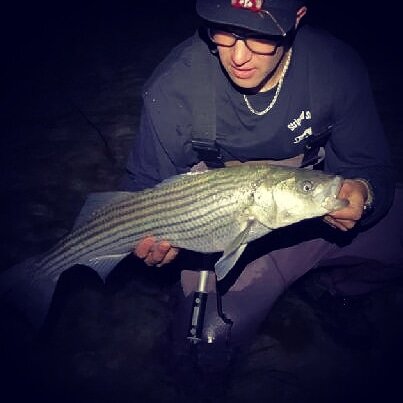Weekly Wrap Up
Another week in the books for the striped survival crew and needless to say, it continues to be a grind. We continue to find a lot of fish cruising the beaches of Cape Cod when most of the world is sleeping. A majority of fish are in the 20 to 26 inch range, however, there are enough 20 pound fish around to keep things interesting.
A healthy fall run bass weighing in at 24 pounds.
On Tuesday night, I headed out on a solo mission for the last 2 hours of the outgoing and the first 2 hours of the incoming. I was fortunate enough to connect with a beautiful 38 inch, 24 pound fish within the first 10 minutes of the trip. The fish fell for a North Bar Tackle Chartreuse Darter (are you surprised?). If you have been following my posts, you know that this plug has been putting on an absolute clinic for the past 2+ weeks. Often times, I find that it is even out producing live eels.
Make sure to have some sort of current in front of you when fishing this lure. If the current is running left to right, cast out at 11 o’clock and reel your slack in. Reel quickly for 1 to 2 seconds, allowing the darter to dig below the surface. Now, back off to a slow retrieve and remain in contact with the lure. Just get ready to set the hook!
It is a pretty simple tactic but extremely effective!
Tuesday night wrapped up with around a dozen fish ranging from schoolies to slot fish and one “over sized” fish. All fish were properly revived and safely released. When landing striped bass in the surf , here are a few things you can do in order to ensure a safe and quick release:
Crush your barbs- No, you will not lose more fish!! Just stay tight to the fish throughout the fight and you will be perfectly fine. By crushing the barbs, it will minimize damage to the jaw and make it extremely easy to remove the hook. Furthermore, if a fish swallows the hook, you will have a much easier time removing the hook and a less likely chance of causing severe damage to the gills. With an abundance of smaller fish around, it is important we make every effort to care for the future of our fishery!
Avoid the boga grip- This is something I have really been trying to work on this year. Research shows that using a boga grip can cause damage to the jaw. Furthermore, if held vertically, the organs shift, causing severe permanent damage to the fish. This affects its ability to forage, digest, etc. Your best bet is to land the fish directly on to the sand, (or better yet, keep them in the water) remove the hook and hold in a vertical position upon release. If you do need the boga grip, continue to hold the fish vertically, minimizing the pressure the boga grip is placing on the jaw. This will ensure the fish is properly supported, minimizing overall damage to both the jaw and inner organs.
Set a timer on your camera phone- Too many times, I witness fishermen fumbling around to pull their phone our for a picture. By the time they find their phone, set the camera up and take a picture, the fish has been out of the water for minutes. I like to keep my phone concealed in my waterproof wader pocket or my surf top pocket. Moreover, I will have the timer set to 5 seconds. This allows me to quickly pull out my phone, take a quick picture and return the fish to the water as quickly as possible. Think of it this way, next time you keep a fish out of the water for 2 minutes, try to hold your breath for that entire time! I bet it won’t be too comfortable…
Take the time to revive the fish- Even the smaller fish will need time to be revived. Avoid pulling the fish forward and backward in the water while reviving. Pulling the fish backwards can cause damage to the gill plate and suffocate the fish. Instead, move the fish in a figure eight or forward motion only. This will ensure water is running through the mouth and out the gills in a natural motion allowing the fish to “breathe”.
These are just a few of the steps you can take in order to ensure a greater future for our striped bass fishery! I urge you to continue to inform others on proper catch and release techniques and to educate those unaware of these techniques. We are all at different skill abilities and I myself am learning something new every trip. Take the time to explain these vital steps instead of bashing someone who may not know any better.
The week wrapped up, after we pulled a 6 hour journey in the surf, Friday night. Before the northeast winds picked up, fish were on the feed tight to shore. The largest of the night was a 30 inch slot fish that was quickly returned to continue her journey south for the fall. A handful of smaller fish kept us busy the remainder of the night until the northeast winds and weeds forced us out. Darters and SP minnows were the top producing lures.
A 30 inch slot fish couldn’t resist the chartreuse darter, even with an overly bloated belly.
Thank you for reading this weeks blog and I hope you found the following information useful! Good luck out there and remember to continue practicing catch and release! The fishing is only going to improve as we head into the prime months of the fall run.
Tight Lines,
Striped Survival - Conserving the Species, Seven Stripes at a Time

